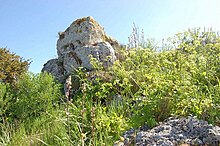Sa curricula
The settlement Sa Turricula in the district of Funtana 'e Casu, of Muros , east of Sassari in the province of Sassari in Sardinia is of fundamental importance for phase B of the Bonnanaro culture in the Middle Bronze Age , which can be connected with the first Protonuraghen . The ceramic materials found in one of the huts during the excavation of Maria Luisa Ferrarese Ceruti in the 1970s gave their name to the cultural phase.
Today Sa Turricula is overgrown with vegetation, but from the top of the hill on which it stands one has a view of the surrounding area that leaves no doubt that the choice of location was a strategic decision more than 3500 years ago, and that given the water supply of the seasonally arrid island.
The proto- , also corridor or pseudonuraghe, has a short semicircular corridor with a recess on the left side. The shape of the structure is influenced by its location on the ridge of Mount Tudurighe. In the construction, megalithic technology was used in the entrance area and dry masonry with medium-sized stones in the back .
The excavation revealed a Punic use in the 3rd century BC. (Punic coins from the Sardinian mint between 241 and 216 BC) and a number of elements from the Roman period. The nuraghe was the place of worship for a goddess of grain. This is evidenced by the discovery of the “Sarda Ceres” type statuettes.
The Grotta dell'Inferno, also called Grotta del Diavolo or Grotta di Scala di Giocca, is located on the west side of Monte Tudurighe. The giant grave of Monte Simeon is 400 m from Sa Turricula .
See also
Web links
Coordinates: 40 ° 42 ′ 27.4 " N , 8 ° 36 ′ 51.5" E
